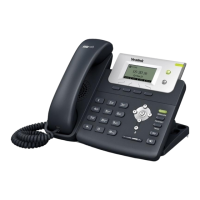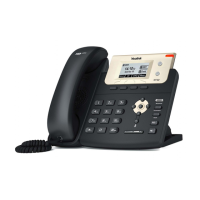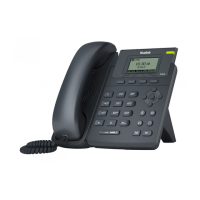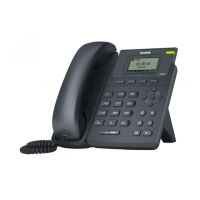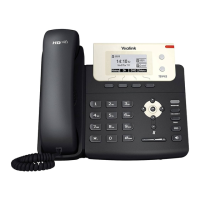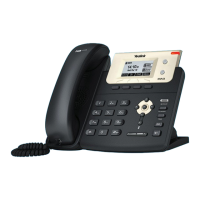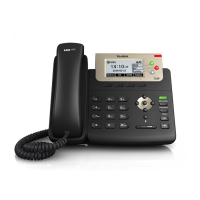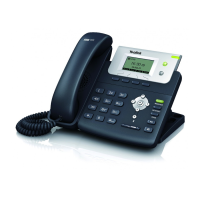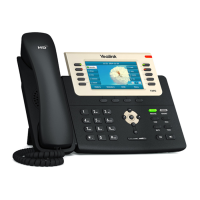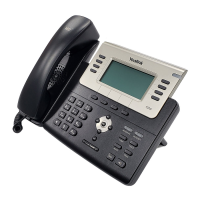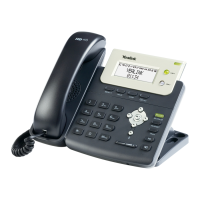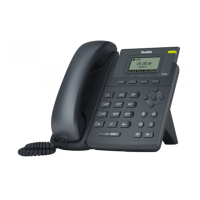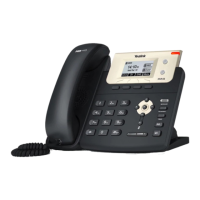






Do you have a question about the Yealink SIP-T21 E2 and is the answer not in the manual?
| Lines | 2 |
|---|---|
| SIP Accounts | 2 |
| Power over Ethernet | Yes (IEEE 802.3af) |
| Wall Mountable | Yes |
| HD Voice | Yes |
| Operating Humidity | 10% to 90% (non-condensing) |
| Network Ports | 2 x 10/100 Mbps Ethernet ports |
| Audio Codecs | G.711, G.722, G.726, G.729, iLBC |
| Protocols Supported | SIP |
| Headset Port | RJ9 |
| Power Supply | AC 100-240V input, DC 5V/1A output |
| Operating Temperature | 0 to 40°C |
| Certifications | CE, FCC, RoHS |
Details the physical parts of the IP phone, including screen, keys, and ports.
Explains the meaning of various icons displayed on the IP phone's LCD screen.
Describes the status indications provided by the phone's LEDs (Power, Line keys).
Outlines the two primary ways to interact with the phone: on-device and web browser.
Lists available documentation for the IP phone, including guides and online resources.
Lists the items included in the SIP-T21(P) E2 IP phone package.
Details accessories that can be purchased separately for the IP phone.
Provides step-by-step instructions for physically setting up the IP phone.
Explains the automatic and DHCP-based initialization process after powering on the phone.
Describes how to view and interpret the phone's current status information.
Guides users on configuring IP settings like IPv4, IPv6, and static IP addresses.
Covers the process of registering the phone's accounts with the server.
Explains the information displayed on the phone when it's not in use.
Details how to input text and numbers using the phone's keypad and input modes.
Covers basic phone customizations like contrast, backlight, language, and time/date.
Explains how to adjust volume and select ring tones for the phone.
Details how to manage contacts, including local directory, blacklist, and remote phone books.
Explains how to view, manage, and delete call history records.
Covers features like logo customization for the phone's idle screen.
Instructions on connecting and activating headset mode for calls.
Information on configuring and using Dynamic Speed Dial (DSS) keys for quick access to features.
Guides on registering and managing SIP accounts on the IP phone.
Explains how to configure rules for automatically dialing numbers and handling call routing.
Details how to configure emergency numbers for quick dialing in critical situations.
Allows the phone to automatically dial numbers without pressing a send key.
Enables immediate dialing of a predefined number upon lifting the handset.
Explains the different methods for initiating a phone call using the handset, speakerphone, or headset.
Details how to answer incoming calls using various audio modes (handset, speakerphone, headset).
Describes how to terminate an active call using the phone's controls.
Covers how to redial the last dialed number or select from call history.
Allows viewing and dialing from the list of placed calls.
Automatically answers incoming calls without manual intervention.
Automatically redials a number if the called party is busy.
Notifies the caller when a busy party becomes available.
Allows placing a call back to the last incoming call.
Temporarily silences the microphone during an active call.
Puts an active call on hold and allows retrieval later.
Rejects incoming calls automatically, with options for phone or custom modes.
Configures the phone to redirect incoming calls to another number or extension.
Enables transferring calls to another party via blind, semi-attended, or attended methods.
Allows receiving a second call while on an active call.
Facilitates setting up conference calls with multiple participants.
Describes creating conferences directly on the IP phone.
Places a call on hold and allows retrieval from another phone in the system.
Allows answering calls directed to other extensions or groups.
Blocks the display of caller ID and phone number when making calls.
Automatically rejects incoming calls from anonymous callers.
Monitors the status of other users' lines and allows quick dialing.
Monitors a predefined list of users' line status and allows interaction.
Enables recording of calls via SIP INFO or URL requests.
Allows users to log in and out of shared phone resources.
Facilitates quick connections with operators or extensions for voice communication.
Broadcasts audio announcements to specific multicast groups.
Plays background music for callers placed on hold.
Distributes incoming calls to registered ACD users in a call center.
Allows sharing an extension across multiple IP phones for simultaneous ringing.
Enables sharing a SIP line on multiple phones, monitoring extension status.
Covers sending, receiving, and managing text messages (SMS) on the phone.
Addresses common problems like finding phone info and MAC addresses.
Troubleshoots problems related to a blank or incorrect LCD screen display.
Solves issues with accessing the web interface or changing user passwords.
Helps resolve problems with receiving or making calls, including DND and blacklist checks.
Diagnoses problems with the phone's handset and headset functionality.
Addresses problems with dial tone, ringing, or call hold tones.
Explains how to export PCAP traces and system logs for analysis.
Guides on rebooting, firmware upgrades, and factory resets for the phone.
Information regarding service agreements applicable to the Yealink product.
Legal disclaimer outlining Yealink's liability for product use and performance.
Crucial safety precautions for device installation, operation, and maintenance.
